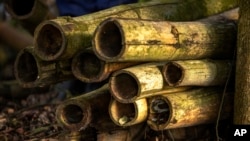Workers dug and chopped the ground along a patch of bush beside a muddy river, looking for bamboo buried beneath the thick grass. There are some bamboos here and there that have grown taller, but most of the bamboo seedlings planted more than a year ago have never grown.
Now, conservation officials are looking to restore 3 kilometers of degraded riverbanks, aiming to plant new bamboo seedlings to make room for last year’s survivors to grow and take better care of them than the first time.
A successful bamboo forest along the Rwezi River – the most important in much of western Uganda, including the major city of Mbarara – will create opportunities for sand miners, subsistence farmers and others who have long threatened the river a buffer. The National Environmental Management Agency estimates that the Loweche River has lost 60% of its catchment area over decades, leaving the meandering river as narrow as a creek in some areas.
“Once the bamboo is built, it almost acts like a net,” said Jeconious Musingwire, an environmental officer who served as a technical advisor on the project. “The roots capture everything, including surface runoff, and stabilize weak points in the river bank.”
Uganda has a growing interest in bamboo, a perennial plant grown in many parts of the world. It can be burned as fuel in rural communities, relieving pressure on dwindling forest reserves of eucalyptus and other natural resources. It is a hardy plant that can grow almost anywhere. Businesses can turn it into products ranging from furniture to toothpicks.
Some of the bamboo species grown in Uganda are imported from Asia, but many – like the bamboo shoots whose shoots are smoked and then boiled for a popular traditional meal in eastern Uganda – grow wild.
The Ugandan government has a 10-year policy to plant 300,000 hectares of bamboo by 2029, mostly on private land, as part of a wider reforestation effort.
This is an ambitious goal. The Uganda Bamboo Association is the largest bamboo association with 340 members but only has a planting area of 500 hectares. Despite growing interest in bamboo cultivation, authorities must encourage more farmers in rural Uganda to plant bamboo on large tracts of land.
But the signs are promising.
Not far from where workers tend the bamboo, there is a large commercial farm of seven acres of bamboo. The plants at Kitara Farm are carefully cared for and there is a stock of 10,000 bamboo poles waiting to be sold.
Administrator Joseph Katumba said the estate has become a model farm for people who want to know more about bamboo. He recalled that when they first started planting bamboo in 2017, someone asked why it was a “waste of land” to plant bamboo when it grows wild in the bushes.
Katuba said the situation has changed and skeptics are now interested in growing bamboo “because they have studied it and like it”. Unlike eucalyptus, a tall flowering plant that is widely grown here for its wood, “there is no bamboo season here. The better you take care of it and weed around it, the more money you make from bamboo.” more.”
Bamboo grows faster than eucalyptus and regenerates like weeds. It also thrives in poor soil. He said new eucalyptus plantings had stopped at Kitala Farm, while bamboo plantings continued to expand.
“We have a lot of eucalyptus forests. But we realize that once the eucalyptus trees are cut down, they will eventually be cut down, and once that’s done, there’s no more money,” he said. “But with bamboo, we looked into it and found that when you grow it … the grandchildren, their grandchildren, their grandchildren are going to make money from the bamboo.”
A bamboo pole earns less than a dollar, so farmers need to grow bamboo poles in large quantities to make enough money. Bamboo promoters urge them to treat bamboo plantations as cash crops in the same way as coffee or tea plantations. Banks offer customers bamboo “plantation capital,” loans that promise to own large quantities of bamboo.
“Everyone should actually grow bamboo, and in large quantities,” said Taga Nuwagaba, a bamboo farmer and businessman who owns a bamboo furniture factory near Uganda’s capital, Kampala. He touts the plant as a renewable resource that sequesters carbon.
“You cut one off and five will grow,” he said.
Kitara Farm consultant agronomist Jacob Ogola said bamboo plants are usually ready for harvest in three to five years and a well-maintained plantation can last at least 50 years. He said bamboo is easy to manage and usually does not require spraying for pests.
Bamboo seedlings are now more widely available through private seedbeds.
Self-described bamboo collector Steve Tusiime owns one such nursery in Mbarara. Tusime said he has been fascinated by the plant ever since he saw it as a child. Before he started planting, he recalled traveling to a farm in central Uganda to “embrace” bamboo, and in 2018 he attended a bamboo conference in China at his own expense, where he got his first batch of bamboo seeds.
Standing on another piece of land on the banks of the Ruwezi River, where he and his partners have created a bamboo park in a yet-to-be-opened leisure resort, he speaks passionately about how bamboo “breathes life” to him.
“Every piece of bamboo you see here has a story. It has its origin, it has a different purpose, it has a different name,” he said. “When you come here, the story is bamboo. You learn about different species, different uses. You see different characteristics of bamboo.”
Still, bamboo plantations in Uganda are not growing fast enough to build an industry around bamboo. Tusiime’s nursery has sold less than 10,000 seedlings in the past two years, which confounds his own assessment of bamboo as an important cash crop that also happens to benefit the environment.
“Bamboo can be the future tree of Uganda and even Africa. For example, you hear people talking about charcoal and firewood and so on. Bamboo is a better solution,” he said. “You can produce briquettes, you can use it directly as firewood. Bamboo is going to be a game changer in Africa. You can eat bamboo, you can build with it, you can create an industry for bamboo, you can feed it to you For animals, it can take care of your land.”
Follow us on Google news ,Twitter , and Join Whatsapp Group of thelocalreport.in


















